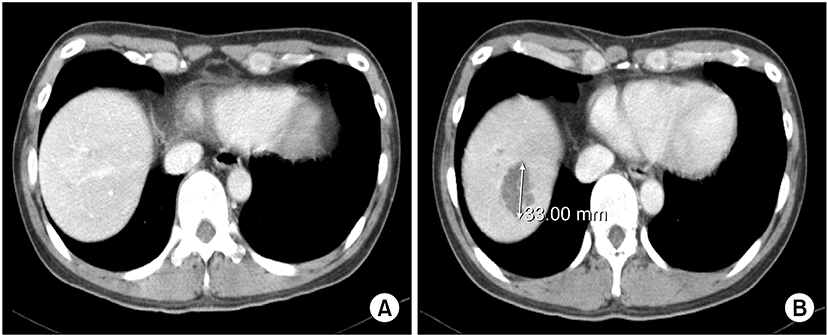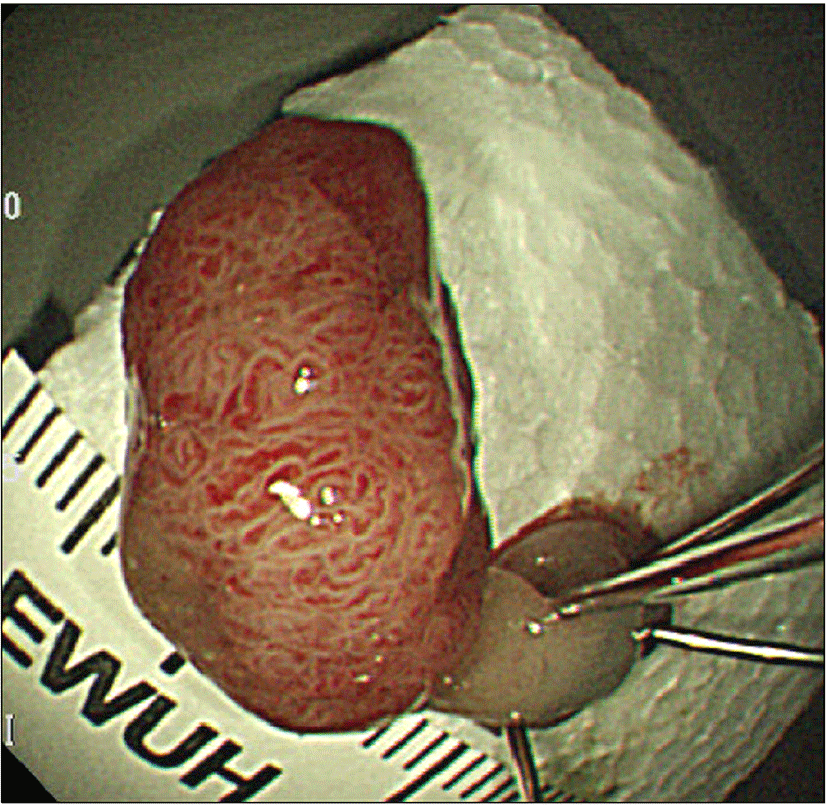서 론
화농성 간농양은 과거에 비해 유병률은 감소하고 있으나 적극적인 치료가 이루어지지 못할 경우 여전히 합병증과 사망률이 높은 감염성 간 질환으로 최근에는 원인균으로 Klebsiella pneumoniae (K. pneumoniae)가 동정되는 경우가 많아졌다. 화농성 간농양은 담도계의 상행성 감염으로 발생할 수 있고 복강 내 감염이 직접 또는 간 문맥을 통해 전파되거나 균혈증과 같은 전신질환이 간동맥으로 파급되어 생길 수 있다[1,2]. 급성 담도염이 간농양의 가장 흔한 원인으로 알려져 있으나 임상적으로 감염 경로를 찾지 못하는 경우도(cryptogenic liver abscess) 많다. 최근에는 대장과 직장의 악성질환이나 관상융모선종(tubulovillous adenoma)이 기저질환이 없는 화농성 간농양에 동반되어 나타나는 사례들이 보고되고 있어 간농양환자에서 대장내시경검사의 필요성이 제기되고 있다[3-6]. 저자들은 첫 번째 간농양을 성공적으로 치료 받은 후 단기간에 재발한 K. pneumoniae 간농양 환자에서 우연히 발견된 대장암을 경험하여 증례를 보고하고자 한다.
증 례
47세 남자 환자가 전일부터 시작된 고열을 주소로 내원하였다. 환자는 당뇨, 고혈압 등의 병력은 없었으나 K. pneumoniae 간 농양으로 치료받은 과거력이 있었다. 환자는 내원 6개월 전에 간 8번 분절에 있는 2.5 cm 크기의 간농양을 진단받고 1주간의 농양 배액과 2주간의 항생제 정맥주사, 5주간의 경구 항생제 치료를 받았었다. 치료시작 14주째 시행했던 복부전산화 단층촬영에서 병변은 거의 소실되었고 이후 환자는 불편한 증상 없이 지냈다(Fig. 1A).
내원 시 우상복부에 경미한 압통과 38.2oC의 열이 있었고 혈압은 정상이었다. 말초혈액검사에서 혈색소 13.3 g/dl, 백혈구 18,700/mm3 (호중구 78%, 림프구 11%), 혈소판 397 K/mm3, 혈청생화학검사에서 AST 45 IU/L, ALT 33 IU/L, 프로트롬빈시간(PT) 12.3초(71%, INR1.21)였고, 알부민 3.8 g/dl, 면역혈청검사에서 C 반응성 단백질(CRP)은 11.36 mg/dl로 상승되어 있었다. 환자의 과거력을 고려하여 복부 단층 촬영을 시행하였고 간 우엽의 7번, 8번 분절에 각각 직경 0.8 cm, 3.3 cm 크기의 간 농양이 새로 발견되었다(Fig. 1B). 말초 혈액과 흡입한 농양의 균 배양검사에서 모두 ESBL음성 K. pneumoniae가 동정되었다. 환자는 입원하여 항생제(ceftriaxone) 정맥주사와 간 농양 배액 (pig-tail insertion) 치료를 받았다.
환자는 치료 4일째에 우안의 결막 충혈과 통증을 호소하였고, 세극동 현미경 검사상 결막 충혈과 삼출, 각막 부종을 보여 간 농양 균혈증에 합병된 안내염 (endophlalamitis)으로 진단되었다. 우안 유리체내 항생제 주입 치료를 즉시 시작하였으나 입원 8일째부터 시력이 악화 되어 유리체 내 스테로이드를 함께 투여하였다. 항생제 치료 5일째에 열이 소실되었고 7일째 시행한 혈액 배양검사에서 균은 동정되지 않았다. 치료 18일째 시행한 복부 초음파검사에서는 간 농양 크기의 감소 및 기질화(organization)가 관찰되었다. 화농성간농양 균혈증과 안내염에 대한 항생제 치료는 총 4주간 시행되었고 더 이상의 시력저하는 없었다.
입원 시 시행한 복부 전산화 단층촬영에서 결장에 용종으로 의심 되는 병변이 발견되어 대장 내시경 검사를 하였고 S상 결장에 2.4 cm 크기의 용종이 발견되었다. 용종은 정상점막으로 덮여 있었고 긴 목을 가지고 있어(Yamada type IV) 올가미(snare)를 이용한 내시경적 용종 절제술로 제거 되었다(Fig. 2). 절제된 용종은 점막하층을 얕게 침범한 중등도 분화를 보이는 선암(Adenocarcinoma moderately differentiated, stage pT1)으로 진단되었으며 절제된 단면에 종양침범은 보이지 않았다. 복부 전산화 단층촬영과 양전자 방출 단층촬영(PET)에서 전이성 병변은 발견되지 않았다.
고 찰
간농양은 원인에 따라 아메바성과 화농성 간농양으로 나뉘며 우리나라에서 아메바성 간 농양은 감소하는 추세이다. 화농성 간 농양의 원인 균으로 1990년대까지는 E. Coli가 가장 많이 보고되었으나 최근에는 K. pneumoniae가 주로 배양되고 있으며 특히 특발성 간농양(cryptogenic liver abscess)의 주된 원인균으로 나타나고 있다[1,2,7].
K. pneumoniae에 의한 화농성간농양에서는 간외에 뇌, 눈, 폐, 비장, 골, 연부조직등에 전이성 감염이 잘 나타나는 것으로 알려져 있다[8]. 혈행성 안내염(septic metastatic endophthalmitis)은 화농성간농양에서 드물게 나타나는 합병증으로 주로 당뇨 환자에서 나타난다. Klebsiella 균혈증 환자의 3∼7.8%에서 안내염이 보고되고 있는데 가장 흔한 원발병소는 화농성 간농양(68%)으로 나타났다[9]. 최근 국내에서는 Yang 등[10]이 패혈증의 초기 증세로 안구 증상만을 호소하여 진단이 늦어진 화농성 간농양 환자를 보고한 바 있다. 세균성 안내염은 안구 침투성이 좋은 3세대 cephalosphorin이나 ciprofloxacin을 전신 정맥 주사하고 유리체강 내에 직접 주입하여 치료하며 망막기능 및 시력 보존을 위해 유리체강 내에 스테로이드를 투여 하기도 한다[11]. 안내염은 심한 경우 영구적 시력 손실을 초래할 수 있어 유리체 절제술, 안구 적축술등 수술적 치료가 필요할 수도 있다. 본 환자의 안내염은 항생제전신 정맥 주사와 함께 유리체강 내 항생제와 스테로이드의 직접 주입으로 치료 되었으며 더 이상의 시력저하는 나타나지 않았다.
Klebsiella에 의한 간농양은 당뇨나 면역저하 환자, 중년 남성에서 호발 한다고 알려져 있다. 적절한 치료 후 Klebsiella 간 농양이 재발하는 경우는 드물며 불충분한 배농이나 부적절한 항생제 사용에 의해 4∼9.1%의 환자에서 재발할 수 있다[12,13]. 화농성 간농양의 재발위험요소로는 담관성 간농양과 당뇨가 있는데[14], 본 증례의 환자는 재발위험요소가 없고 완전한 배농과 7주간의 항생제 치료를 했음에도 불구하고 간농양이 단기간에 재발한 흔하지 않은 예이다.
간 농양을 처음 진단받았을 당시 환자는 당뇨, 고혈압, 면역저하가 없었고 간담도계나 복강내 이상 소견도 발견되지 않아 원인이 명확하지 않은 특발성 간농양(cryptogenic liver abscess)으로 진단할 수 있었다. 특발성 화농성 간농양은 전체 화농성 간농양의 1/3 정도를 차지하는데[15], 최근에는 대장내 악성종양이나 용종과 동반되어 나타나는 증례들이 보고 되고 있다. Hsu 등은 충분한 치료에도 불구하고 1년에 3차례나 재발한 Klebsiella 간 농양 환자에서 대장암을 발견하여 보고하였으며[16], Weng 등은 Kebsiella 간 농양에 속발한 Streptococcus bovis 심내막염 환자에서 대장암이 진단된 사례를 보고하였다[17]. 대장 종양에 의한 점막 손상을 통하여 장내 세균이 간문맥에 침투하는 것으로 생각되며 이 경우 증세가 없는 대장 종양이 특발성 화농성 간농양의 양상으로 발현될 수 있다.
화농성 간농양 환자에서 대장암 유병률은 연구에 따라 다양하게 보고되고 있다. Hiraoka 등이 화농성 간 농양 환자에서 악성 종양의 발생빈도를 조사한 연구에 따르면 41명의 화농성 간 농양 환자 중 12명에서 악성 종양이 발생하였는데 간세포암 3명, 담관암 3명, 췌장암 1명, 담낭암이 1명이었으며 간담도계 외 암으로는 대장암이 3명, 폐암이 1명이었다[18]. Cohen 등[19]과 Nosher 등[20]은 화농성 간농양 환자에서 대장암의 유병률을 5% (1/20명)와 6.7% (1/15명)로 보고하였다.
특발성 화농성 간농양으로 진단된 274명과 인구 자료로 무작위 선정한 1,644명의 대조군을 나이, 성별로 짝지어 5년간 추적 관찰한 대규모 연구에서 간농양군에서 15명(5.45%), 대조군에서 25명(1.82%)의 환자들이 각각 대장암을 진단받았다. 이 연구에서 Hseueh 등[21]은 화농성 간농양 환자에서 5년 내 대장암이 발생 할 위험이 높아(hazard ratio; 3.12) 특발성 간농양 환자에서 대장암에 대한 적극적 검사가 필요하다고 주장하였다. 그러나 Zakout 등[15]은 화농성 간농양과 대장암의 연관성을 보고 한 많은 증례에서 환자들이 대장증세를 보여 대장내시경을 시행하였고 대규모 연구에서도 환자군이 대조군에 비해 검사에 더 적극적이었다는 점을 비판하며 화농성간농양과 대장암 사이에 명확히 인과관계가 입증되지 못한 상태에서 대장내시경을 특발성 간농양의 필수 검사에 포함하는 것은 적절하지 않다고 주장하였다
본 증례는 간농양 발생과 재발의 위험인자가 없는 성인에서 적절한 초기 치료에도 불구하고 K. pneumoniae 간농양이 단기간에 재발한 드문 경우로 동반된 대장암이 우연히 진단되어 특발성 화농성 간농양과 대장암의 연관성을 시사하는 사례이다. 화농성 간농양 환자에서 대장내시경을 일괄적으로 시행해야 하는지에 대해서는 아직 합의된 바가 없다. 그러나 대장 선종의 과거력이 있거나 본 증례와 같이 적절한 치료에도 불구하고 원인 모르게 재발하는 간농양 환자에서는 대장 내시경 검사가 필요할 것으로 생각된다.



